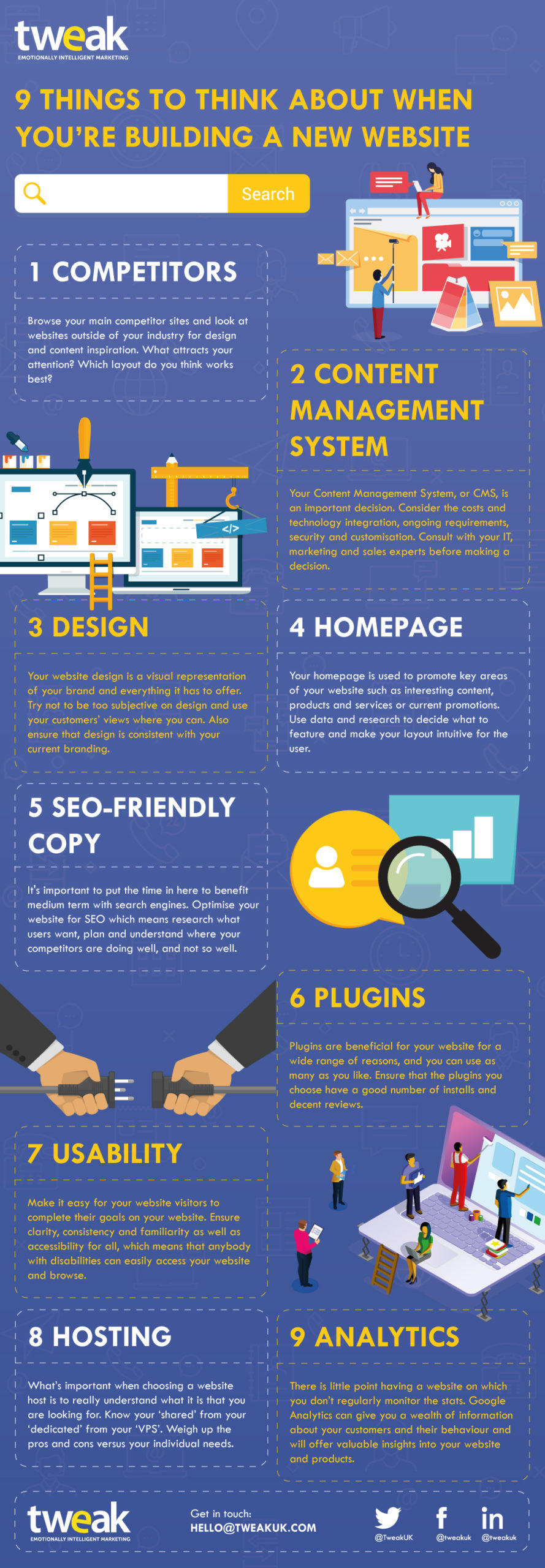You’ve made the decision to go ahead and build a new website and you’ve had the budget signed off – the first hurdles are cleared. But what next? Take a look at our simple guide – 9 things that you might like to bear in mind when you’re building a new website.

1. Competitors
Browse your main competitor sites, and by competitors, we mean both those that you consider to be a competitor and those with which Google thinks that you compete for organic traffic. You may also find it useful to look at websites outside of your industry for design and content inspiration. Make a note of the features and details that draw your attention. Are you attracted to really engaging videos, clever use of infographics or a really creative Meet the Team page? What do other companies promote on their homepage and do you think that it works? It may be helpful to audit your closest competitors from an SEO perspective to see if the content that they are producing on their site is earning them brownie points with Google.
2. Content Management System
Your Content Management System, or CMS, is an important decision. Once you’ve made that decision, it’s difficult to change so spend time weighing up the different options. Consider the costs and technology integration, ongoing requirements, security and customisation. If you are a blogger then you’ll choose a different solution to a small company selling crafts online or a tech brand that’s aiming to increase awareness of its services. Ensure that you consult with your IT, marketing and sales experts before making the decision as their roles will be affected by your choice.
3. Design
Your website design is a visual representation of your brand and everything it has to offer. Design tends to rightly get a lot of focus during the new website process. From our perspective it doesn’t really matter if you want your website to be hot pink or dark brown as long as your visitor can recognise it as your brand, it has a clear and concise format, it’s optimised for SEO and accessible to everybody. Try not to be too subjective on design and use your customers’ views where you can. For example, on social media, you could create a poll ‘are you more engaged with image 1 or image 2’? Or there’s always the option to A/B test two versions of the same page to see which customers interact with most.
4. Homepage
Your homepage is, effectively, your shop window. It’s a way to promote other key areas of your website such as interesting content, key products and services or current promotions. It’s really important that your homepage is visually appealing and employs a clear structure so your visitor can find exactly what they need quickly and efficiently. If you’ve already had a website for your brand before, then use Google Analytics to understand which pages your visitors are most interested in. Which pages have the highest numbers of pageviews? On which pages do your visitors spend the most time? What tends to be a usual customer journey prior to conversion? Use this information when putting together your new homepage and don’t waste the real estate on products and services that you may want to push but are not interesting to your website audience, for whatever reason.
5. SEO-friendly copy
It’s tempting and less time-consuming to just copy over your brochure copy on to your web pages and job’s a goodun! However we suggest that you spend time optimising your website for SEO. By this we mean ensuring that your key topics are researched from an SEO point of view and that they’re answering search queries in Google. And that your website ticks all the boxes from a technical SEO point of view. Do all your pages have meta descriptions? H1 headings? Image tags? We could go on. The most important single factor for SEO is to provide useful and informative content for the reader. If you do this, then your audience will visit, they’ll spend time, you’ll acquire backlinks, and, with all fingers crossed, higher rankings with Google as a result.
6. Plugins
Plugins are beneficial for your website for a wide range of reasons, and you can use as many as you like, but bear in mind that in some cases they can slow down your page load time so do tread carefully. Whatever you wish to do on your website – compress imagery, add contact forms, feature a live chat functionality or schedule backups – there’s pretty much always a plugin that can do the job for you. On WordPress alone, there are 56,000 plugins which can make it difficult to choose when you are not familiar with building websites. We suggest that when you are researching, use a plugin that is relevant to what you need, has a good number of installs and good reviews. Also, make sure that it has been tested with a recent version of WordPress.
7. Usability
Design your website with usability in mind. By usability, we mean the ease with which your visitor can complete their goals on your website. First of all make sure that your website is clear for your visitor. By clear, we mean simple, consistent in its design and familiar. If your offline marketing is always bright blue, then ensure that you feature this colour on your homepage. Your website should also be available to everybody and accessible for those with disabilities. If you want to check yours for free, visit https://wave.webaim.org/. Furthermore, make sure that your layout is intuitive and what your visitors expect. For example it’s standard to have ‘About us’ in the top navigation and social logos at the bottom of the homepage.
8. Hosting
What’s important when choosing a website host is to really understand what it is that you are looking for. Know your ‘shared’ from your ‘dedicated’ from your ‘VPS’. If you’re a small one-man-band company and intend to remain that way, then you’ll need an entirely different solution from a medium company that is growing with high volumes of traffic viewing the website daily. Also what is the function of your site? Is it primarily for a blog? Or to sell your products online? Or for a growing business? Again, you might choose different solutions for every option. Understand how much storage you’ll need as your hosting service will ensure that your content loads at an appropriate time for your site visitor, even if you have a huge site. Hosts also guarantee a certain amount of ‘uptime’. Needless to say, it’s important that your website is accessible as often as possible.
We suggest not to just go for the cheapest option but to weigh up the pros and cons according to your individual needs. This article from Tech Republic helps explain more about hosting:
https://www.techrepublic.com/article/how-to-choose-the-best-web-host-a-cheat-sheet/
9. Analytics
There is little point having a website on which you don’t regularly monitor the stats. Google Analytics is the standard analytics tool to employ on your website and it can give you a wealth of information about your customers and their behaviour. Are they particularly interested in one of your products shown by a high number of recent users to the page? Are they spending a long time viewing a particular piece of content and what does that tell you about them? Do you have a lot of website visitors but few enquiries? Why might this be? Regular stats and insights are so important to learn what’s happening and how you can continue to move forward and grow your online presence, attracting more traffic and conversions.
We hope that this guide helps and if you need assistance or advice with your website please send us an email at HELLO@TWEAKUK.COM
